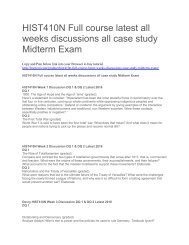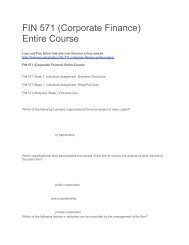GED 216 Unit 2 Examination Answers
You also want an ePaper? Increase the reach of your titles
YUMPU automatically turns print PDFs into web optimized ePapers that Google loves.
<strong>GED</strong> <strong>216</strong> <strong>Unit</strong> 2 <strong>Examination</strong><br />
<strong>Answers</strong><br />
Copy and Pate below link into your Browser to buy tutorial<br />
http://hwpool.com/product/ged-<strong>216</strong>-unit-2-examination-answers/<br />
<strong>GED</strong> <strong>216</strong> <strong>Unit</strong> 2 <strong>Examination</strong> <strong>Answers</strong><br />
1. Carol Gilligan’s work on the issue of self-esteem in girls showed that<br />
girls begin with low self-esteem, but it gradually increases as they progress through<br />
adolescence.<br />
at all ages, girls have higher self-esteem than boys.<br />
at all ages, boys have higher self-esteem than girls.<br />
girls begin with high levels of self-esteem, which gradually decrease as they go through<br />
adolescence.<br />
2. George Herbert Mead considered the self to be<br />
the part of an individual’s personality that is composed of self-awareness and self-image.<br />
the presence of culture within the individual.<br />
basic drives that are self-centered<br />
present in infants at the time of their birth.<br />
3. Mead placed the origin of the self on<br />
biological drives.<br />
<br />
social experience.<br />
the functioning of the brain.<br />
4. According to Mead, social experience involves<br />
understanding the world in terms of our senses.<br />
the exchange of symbols.<br />
a mix of biological instinct and learning.<br />
acting but not thinking.<br />
5. By “taking the role of the other,” Mead had in mind<br />
imagining a situation in terms of past experience.<br />
recognizing that people have different views of most situations.<br />
imagining a situation from another person’s point of view.<br />
trading self-centeredness for a focus on helping other people.<br />
6. When Cooley used the concept of the “looking-glass self,” he claimed that<br />
people are self-centered
people see themselves as they think others see them.<br />
people see things only from their own point of view.<br />
our actions are a reflection of our values.<br />
7.According to Mead, children learn to take the role of the other as they model themselves on important<br />
people in their lives, such as parents. Mead referred to these people as<br />
<br />
<br />
<br />
<br />
role models.<br />
looking-glass models.<br />
significant others.<br />
the generalized other.<br />
8. In Mead’s model, which sequence correctly orders stages of the developing self?<br />
imitation, play, game, generalized other.<br />
imitation, generalized other, play, game<br />
imitation, game, play, generalized other<br />
imitation, generalized other, game, play<br />
9. Mead used the concept “generalized other” to refer to<br />
important individuals in the child’s life.<br />
a person who provides complete care for a child<br />
any “significant other.”<br />
widespread cultural norms and values people take as their own.<br />
10. Mead would agree that<br />
socialization ends with the development of self in childhood<br />
if you won $100 million in a lottery, yourself might change.<br />
people are puppets with little control over their lives.<br />
human behavior reflects both nature and nurture.<br />
11. Erik H. Erikson’s view of socialization states that<br />
personality develops over the entire life course.<br />
personality involves tensions between the forces of biology and forces of culture.<br />
we come to see ourselves as we think others see us.<br />
most of our personality development takes place in childhood<br />
12. Critics of Erikson’s theory of personality development point out that<br />
not everyone confronts the stages in the exact order given by Erikson.<br />
his theories are difficult to test scientifically.<br />
a large percentage of people never reach the last stage of development.<br />
his research suffers from a gender bias.<br />
13. Family is important to the socialization process because<br />
family members are often what Mead called “generalized others.”<br />
families pass along social identity to children in terms of class, ethnicity, and religion.
families begin the process of anticipatory socialization.<br />
families set the stage for resocialization.<br />
14. Shawna is an excellent artist, but as a mother, she feels that she cannot work and devote<br />
enough time to her family. She is experiencing<br />
role conflict.<br />
role strain.<br />
role ambiguity.<br />
role exit.<br />
15. Which concept refers to the tension among roles connected to a single status?<br />
role conflict<br />
role strain<br />
role ambiguity<br />
role exit<br />
16. Which concept is involved when a surgeon chooses not to operate on her own son because<br />
the personal involvement of motherhood could impair her professional objectivity as a physician?<br />
role conflict<br />
role strain<br />
role ambiguity<br />
role exit<br />
17. Which concept is involved when a plant supervisor wants to be a good friend and confidant to<br />
the workers, but must remain distant in order to rate the workers’ performances?<br />
role conflict<br />
role strain<br />
role ambiguity<br />
role exit<br />
18. What is the term for the process by which people disengage from important social roles?<br />
role rejection<br />
role reversal<br />
role loss<br />
role exit<br />
19. Rebuilding relationships with people who knew you in an earlier period of life is a common<br />
experience for those who are undergoing<br />
role conflict.<br />
role strain.<br />
role ambiguity.<br />
role exit.
20. Which concept is used to designate the process by which people creatively shape reality as<br />
they interact?<br />
status interaction<br />
social construction of reality<br />
interactive reality<br />
role reality<br />
21. Flirting is a playful way of seeing if someone is interested in you without risking outright<br />
rejection. From this point of view, flirting illustrates<br />
the Thomas theorem.<br />
the process of role exit.<br />
the social construction of reality.<br />
street smarts.<br />
22. The Thomas theorem states that<br />
a role is as a role does.<br />
people rise to their level of incompetence.<br />
situations defined as real are real in their consequences.<br />
people know the world only through their language.<br />
23.Garfinkel’s research, an approach called ethnomethodology, involves<br />
<br />
<br />
<br />
<br />
studying the way people make sense of their everyday surroundings.<br />
tracking people’s roles over the life course.<br />
the study of interaction in terms of theatrical performance.<br />
studying unfamiliar cultural systems.<br />
24. An example of a secondary group is<br />
a fraternity chapter meeting on campus.<br />
a Microsoft Corporation awards banquet.<br />
parents meeting with their daughter and her coach.<br />
girl scouts at a cookout.<br />
25. In general, we see a(n) _______ as a means to an end; we see a(n) _____ as an end in itself.<br />
expressive group; instrumental group<br />
crowd; category<br />
secondary group; primary group<br />
primary group; secondary group

















